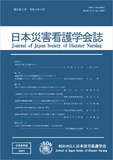Japanese
English
- 有料閲覧
- Abstract 文献概要
- 参考文献 Reference
要約
1.目的
東日本大震災において、DMATが被災地でどのような活動を展開し、そこにはどのような活動システム内の矛盾が存在したのかを明らかにする。
2.方法
質的記述的研究。東日本大震災においてDMATとして活動した看護師2名を研究協力者とし、半構成的面接法により、被災地での活動内容、被災者の反応等を語ってもらった。逐語録を作成し、内容は活動理論の構成要素に基づいて分類した。それをもとに活動システム内の矛盾について検討した。
3.結果
東日本大震災におけるDMATの活動では、「主体であるDMATと共同体である被災者の間に存在したルール」「DMATと自治体職員などの共同体の間に存在した分業」においてそれぞれ矛盾が生じていた。
4.考察
東日本大震災での活動における矛盾が生じた要因として、甚大な津波被害や被災地域が広範囲に及んだことで、情報収集が極めて困難であったことが考えられた。また、多職種との連携においては、相互の役割認識が不十分であったことで、役割分担や協働に時間を要したことが推察された。
Abstract
1. Purpose
The purpose of this study was to clarify how DMAT activities unfolded in disaster areas following the Great East Japan Earthquake and what kinds of inconsistencies existed in the activity systems.
2. Methods
This was a qualitative descriptive study conducted with the cooperation of two nurses who worked on DMATs during the Great East Japan Earthquake. In semi-structured interviews, the nurses described the content of activities in the disaster areas, the responses of the victims, and other information. Verbatim transcripts were made, and the content was classified based on the constituent elements of activity theory. Subsequently, inconsistencies within the activity systems were investigated.
3. Results
In DMAT activities during the Great East Japan Earthquake, inconsistencies stemmed from "rules that existed between the DMAT as the main actor and disaster victims as a collaborative body" and "the division of labor that existed between DMATs and collaborative bodies such as local government staff."
4. Discussion
The significant difficulty in gathering information as a result of the tremendous tsunami damage and the broad extent of the disaster areas was thought to be a factor in the occurrence of inconsistencies in the activities of DMATs following the Great East Japan Earthquake. It was also conjectured that, due to the lack of mutual awareness of roles, it took time to divide roles and work together collaboratively in coordination with other professional groups.
Copyright © 2023, Japan Society of Disaster Nursing All rights reserved.


